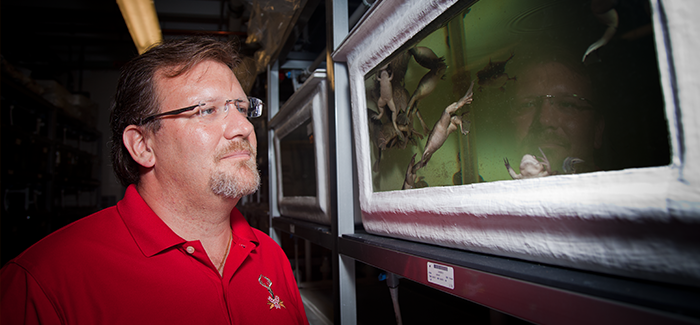
Marko Horb. (Photography by Daniel Cojanu)
The National Xenopus Resource at the Marine Biological Laboratory supports frog research with far-reaching implications.
Marko Horb’s relaxed demeanor matches the slow-to-rise mood of a cloudy summer morning in Woods Hole, Massachusetts. Holding a cup of coffee, Horb offers a walking tour of the Marine Biological Laboratory’s National Xenopus Resource. He directs the facility, which manages stocks of the Xenopus genus of frogs to meet the diverse needs of far-flung researchers.
Navigating rows of tanks filled with frogs in various stages of development, Horb describes the center’s species and their uses, and the facilities and equipment available. His calm never wavers, but there’s a lot of ground to cover and the flow of information takes on a gradually more caffeinated affect.
There are two species available, X. laevis and X. tropicalis. Large and easy to maintain, X. laevis, known as the African clawed frog, is useful for studying embryology and developmental biology, in part because of its reproductive frequency. “Unlike most amphibians that lay once a year,” Horb says, “these guys lay every three months.”
X. tropicalis, the Western clawed frog, is smaller but grows faster than X. laevis, and has a less complex genome that allows for more genetic manipulation. In all the National Xenopus Resource produces more than 50 transgenic lines for an array of research purposes.
[[{"type":"media","view_mode":"media_original","fid":"1926","attributes":{"alt":"","class":"media-image","height":"494","typeof":"foaf:Image","width":"460"}}]]
Xenopus frogs’ capacity for tissue, organ, and limb regeneration also makes them an important subject for medical research. In his work, Horb focuses on the pancreas in X. laevis to understand the genetic underpinnings of diabetes.
The four-year-old facility, one of just 28 Animal and Biological Material Resource Centers in the United States, houses more than 2,000 frogs bred based on research priorities. The interests of an international community of Xenopus scientists help determine the genetic stocks that the center maintains. Researchers can order frogs to be shipped or rent space and equipment at the MBL. “We’re trying to establish sort of a pipeline,” Horb says.
Toward that end, they coined the term “research hotel” to express the breadth of services offered on site. For $500 a week, the center provides frogs, chemicals, “anything normal,” Horb says, to many biologists who wouldn’t otherwise be able to conduct such research. “If you wanted to use ten different transgenic lines, you’d have to have a lot of space,” he says. “Most people can’t afford that.”
Affordable access to the National Xenopus Resource, on the other hand, makes the MBL a global attraction for frog research. “This year, for example, we have one person from Spain, one person from California,” Horb says. “We’ve got a guy in here for two weeks; he’s up from Cincinnati. Another one from North Carolina.”
In another building, where Horb has his lab and more space for visiting researchers, it’s almost as if the conversation picks up where it left off earlier. “… like Christina, she’s visiting, and there’s Bob there, he’s visiting.”
[[{"type":"media","view_mode":"media_original","fid":"1927","attributes":{"alt":"","class":"media-image","height":"414","typeof":"foaf:Image","width":"460"}}]]
He opens a door to an adjoining room to find a scientist hunched over a table holding a frog above a petri dish. “He’s just squeezing the eggs out,” Horb says.
The researcher’s extraction technique mimics natural mating, where the male squeezes the female’s waist to prompt her to lay eggs, which are fertilized externally. Natural mating also occurs at the facility, but the controlled technique allows for timed fertilization and synchronous development of the embryos.
Finite space and funding make it tricky to provide an international community of Xenopus biologists with the means to do their work. Serving those scientists also demands responsiveness to varied and ever-evolving requests. Horb serves, in effect, as the manager of a one-stop research shop.
“The idea is just trying to figure out which lines have greater demand,” Horb says. “It’s a stocking issue, basically,” one that requires nimble administration to meet scientific needs, but the National Xenopus Resource is nothing if not well stocked.
